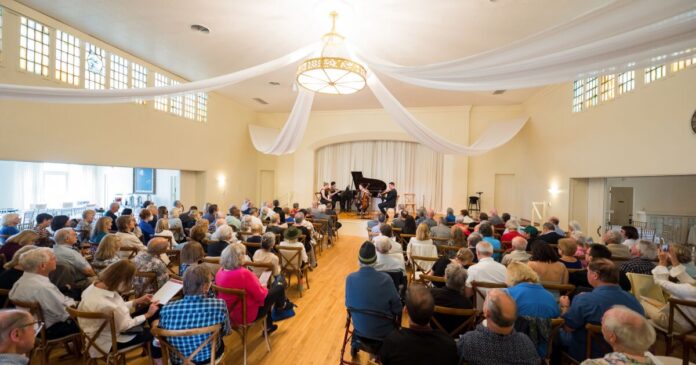
The La Jolla Women’s Club is a lovely building, one of a number of important designs in San Diego by architect Irving Gill. Tucked away behind thick hedges, it’s hard to spot from the street, so those folks who know it, know it largely due to their own access to the events there, making it a fitting venue for Sunday’s season-ending concert by Le Salon de Musiques, a series of concerts hosted by Artistic Director Francois Chouchan.
The concert on June 25 featured music by women composers, and chamber works by Fanny Mendelssohn (the older sister of Felix), Amanda Maier and Dora Pejačević.
Mendelssohn’s 1847 Trio in D minor, op. 11, was a birthday gift to her sister, and is an expansive work, rich in melodies, with an especially virtuosic piano part, dispatched with impressive grace by pianist Chi-Jo Lee. In the first movement, Lee seemed a bit hesitant to overshadow her peers, and one wished for a bit more force in her playing. Violinist Gallia Kastner brought a grand sweep to her phrases, and the duet playing between her and excellent cellist Allan Ho was elegant and detailed. Lee was more effective in the slow movement, which opens with carefully articulated chorale-like chords in the piano, and she shone further in the third movement, which is marked “Lied” (or “Song”) but functions as a cadenza, and her ability to command and slow the dramatic pacing was compelling.
Swedish composer Maier’s “Six Pieces for Violin and Piano” was a welcome surprise. In 1872, Maier became the first woman graduate in music direction from the Royal College of Music in Stockholm; her writing shows both a knowledge and integration of the musical trends of her day — her work has a real kinship with both Brahms and Grieg—but hers is an original and creative language. The “Six Pieces” are her “Moments Musicaux,” a set of varied and inventive character works in diverse formal plans. Kastner and Lee were artful in their ability to highlight subtle affective details, making the most of the unique quality of each movement. Kastner has an explosive and expressive sound, and dug into the rushing staccato melodies in the fourth movement Allegro. She and Lee brought one illuminated sound to the gentle hurdy-gurdy of the final movement, a charming and dear melodic gesture that sounds every bit like the Shaker hymn “Simple Gifts.”
While the focus of the concert’s programming was inclusivity — an opportunity to hear voices long marginalized by history and power, various details of Sunday’s event got in the way of that idea.
First was the pre-concert introduction by Nuvi Mehta. Mehta is a savvy and gifted speaker, though his remarks belied, to an extent, the event’s mission.
The discussion of the absence of women’s art in the canon, concert hall and classroom has gone through several distinct phases over the years: in the first, it simply wasn’t talked about, with the implicit (sometimes explicit) assumption that women simply didn’t create works that were as rich as their male counterpoints. That was replaced by a second narrative, one in which, sadly, women weren’t given the opportunity to develop as artists and that’s why we don’t have many works to choose from. This was a theme in Mehta’s remarks, and this is an analysis that while superficially true, it leaves the past, and us, alone. More recently, this notion has been replaced by the challenging idea that, indeed, there were women artists, many of them, and their works and their importance have been systematically erased (Maier, a celebrated composer during her life, is a prime example of this fact), and, our job is to find their music and to program it.
Moreover, the choice to program the last piece seemed unfortunate. Pejačević was an important Croatian composer, who came from extreme privilege, apparently renouncing the idea of her wealth (if not the wealth itself) in her later years. Her C Major Trio is an attractive piece, absolutely worth being heard, and was played very capably by the three musicians. However, there are, out there, literally thousands of more original, vital pieces by women composers, especially living ones. To include a work by a member of the highest elite, and to have it performed in an utterly exclusive venue seemed just a bit tone-deaf, in light of the Salon’s meaningful attempt to welcome unheard voices in our collective musical discourse.
Schulze is a freelance writer.



